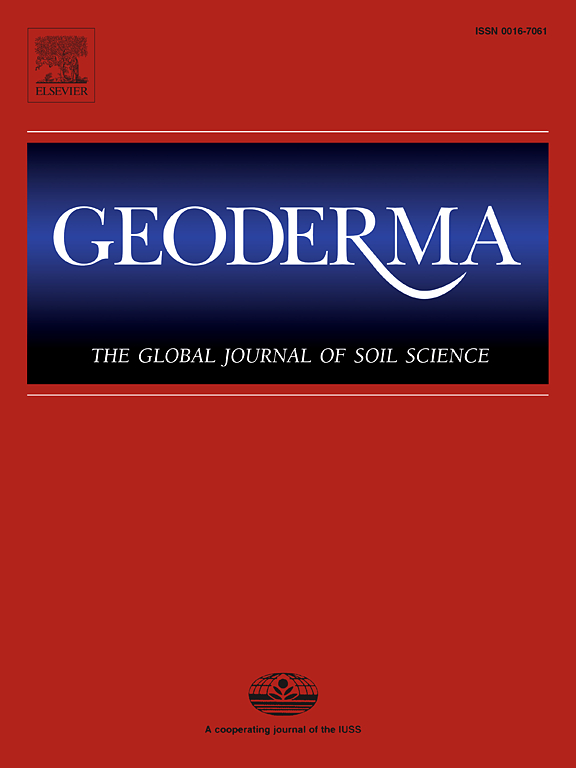Increasing ECM tree dominance enhances soil lignin phenols but suppresses microbial necromass contribution to soil organic carbon in a subtropical mountainous forest
IF 6.6
1区 农林科学
Q1 SOIL SCIENCE
引用次数: 0
Abstract
Arbuscular mycorrhizal (AM) and ectomycorrhizal (ECM) plants exhibit distinct litter quality characteristics and nutrient uptake strategies that critically influence soil carbon and nitrogen cycling. However, the effect of mycorrhizal type on soil organic carbon (SOC) accumulation remains unclear, particularly in tropical and subtropical forests in China. To address this knowledge gap, this study quantified the SOC content and its components across a gradient of ECM tree dominance (ECM%, defined as the proportion of ECM tree basal area relative to the all trees) in a subtropical mountainous forest. Lignin phenols and amino sugars were used as indicators of plant- and microbial-derived C in the soil, respectively. Plant, soil, and microbial properties were analyzed to explore the underlying mechanisms influencing SOC components across different mycorrhizal types. Our results indicated that ECM% did not affect SOC content but significantly altered SOC composition. Specifically, a higher ECM% promoted plant-derived C accumulation and reduced microbial-derived C. The increase in plant-derived C accumulation with ECM% was primarily owing to lower litter quality and higher C inputs from litter and fine roots. Conversely, microbial-derived C accumulation decreased with ECM%, primarily because of the lower metabolic efficiency and higher degradation rate of microbial necromass, as indicated by metabolic quotient and extracellular enzyme activities, respectively. Overall, these findings improve existing understanding of the mechanisms underlying SOC formation and decomposition along the gradient of ECM tree dominance, providing valuable insights into how shifts in tree mycorrhizal dominance under global change may alter the pathways and composition of SOC accumulation in forest soils.
增加ECM树优势增加了土壤木质素酚,但抑制了亚热带山地森林微生物坏死团对土壤有机碳的贡献
丛枝菌根(AM)和外生菌根(ECM)植物表现出不同的凋落物质量特征和养分吸收策略,对土壤碳氮循环有重要影响。然而,菌根类型对土壤有机碳(SOC)积累的影响尚不清楚,特别是在中国热带和亚热带森林中。为了解决这一知识空白,本研究量化了亚热带山地森林中有机碳含量及其组分在ECM树优势度(ECM%,定义为ECM树基部面积相对于所有树木的比例)梯度上的含量。木质素酚和氨基糖分别作为土壤中植物源和微生物源C的指示物。分析了植物、土壤和微生物特性,探讨了影响不同菌根类型有机碳组成的潜在机制。结果表明,ECM%不影响有机碳含量,但显著改变了有机碳组成。具体而言,较高的ECM%促进了植物源性碳积累,降低了微生物源性碳积累。随着ECM%的增加,植物源性碳积累的增加主要是由于凋落物质量降低,凋落物和细根的碳输入增加。相反,微生物来源的C积累随着ECM%的增加而减少,这主要是由于代谢商和细胞外酶活性分别表明,微生物坏死块的代谢效率较低,降解率较高。总的来说,这些发现改善了对有机碳形成和分解机制的现有理解,为全球变化下树木菌根优势的变化如何改变森林土壤有机碳积累的途径和组成提供了有价值的见解。
本文章由计算机程序翻译,如有差异,请以英文原文为准。
求助全文
约1分钟内获得全文
求助全文
来源期刊

Geoderma
农林科学-土壤科学
CiteScore
11.80
自引率
6.60%
发文量
597
审稿时长
58 days
期刊介绍:
Geoderma - the global journal of soil science - welcomes authors, readers and soil research from all parts of the world, encourages worldwide soil studies, and embraces all aspects of soil science and its associated pedagogy. The journal particularly welcomes interdisciplinary work focusing on dynamic soil processes and functions across space and time.
 求助内容:
求助内容: 应助结果提醒方式:
应助结果提醒方式:


